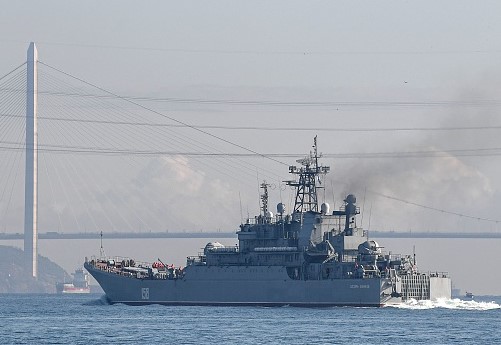Growing Concerns Over Naval Safety
Russia’s military presence in Syria has seen a significant change recently, as key naval assets have withdrawn from the Mediterranean seaport in Tartus. This move comes as the Syrian civil war intensifies, and President Bashar al-Assad’s government faces growing challenges from opposition forces. Tartus, located on Syria’s coast, has long been an important base for the Russian Navy, serving as a logistics hub and a repair station for Russian naval vessels in the Mediterranean Sea. But now, as the conflict in Syria escalates, maintaining a Russian military presence in the region has become increasingly difficult.
The departure of the auxiliary vessel Yelnya on December 2, 2024, was one of the earliest indications of this change. Other reports suggest that several other ships, including frigates and a submarine, may have left the port as well. At the time, Russia’s naval task force in the Mediterranean consisted of multiple vessels, including Grigorovich-class frigates, the Mercury corvette, Gorshkov-class frigates, and the diesel-electric submarine Ufa. These vessels were part of the Russian military effort to maintain influence and provide support to Assad’s forces.
Tartus: A Key Naval and Strategic Location
Tartus holds strategic importance for Russia. While Russia officially refers to it as a “logistics hub” rather than a full military base, the port has been crucial for Russian operations in the region. Since Russia entered the Syrian civil war in 2015, the port has been used to supply and repair naval assets, including warships and submarines. Additionally, Tartus has been a crucial point of entry for Russian special troops assisting the Assad regime in its conflict with several rebel factions.
In 2017, Russian President Vladimir Putin ordered the expansion of the Tartus facility, making it even more important to Russia’s military operations in the Middle East. The port’s significance grew even further after 2022, when Türkiye restricted access to the Black Sea for warships following Russia’s invasion of Ukraine. This restriction made Tartus a vital gateway for Russian naval power in the Mediterranean and beyond.
However, recent events indicate that maintaining control of the port has become more challenging for Russia. The Syrian civil war, which began in 2011, has been marked by a series of shifts in control and violent escalations. In recent weeks, these escalations have reached new heights, with opposition forces making significant territorial gains. This has put both the Assad regime and its Russian allies in a precarious position.
Escalating Violence and the Withdrawal of Russian Assets
The latest developments in Syria have been alarming. On November 27, 2024, a coalition of opposition forces led by the militant group Hayat Tahrir al-Sham (HTS) launched a major offensive. This offensive led to the capture of much of Aleppo, Syria’s second-largest city, and pushed toward Hama, a key government-controlled area. As these rebel forces advanced, they also threatened the main road that connects the capital, Damascus, to other parts of Syria.
The rapid gains made by the opposition forces caught Assad’s military off guard. The Assad regime, once able to rely on Russian support to reclaim territory, now faces serious challenges as rebels take control of large portions of Syria. These developments signal a dramatic shift in the dynamics of the Syrian conflict, making it harder for Russia to maintain its naval presence in the region.
The withdrawal of Russian naval assets from Tartus may be a reflection of these growing challenges. The safety and security of Russian military assets in the region are increasingly uncertain, and the decision to pull back forces from Tartus could be an indication that Russia is reevaluating its ability to secure the area.
Tartus Tension: Shifting Dynamics in Russia’s Strategy
The Syrian civil war has been ongoing for more than a decade, and while Russia has provided significant support to the Assad government, the tide of battle has not always been in their favor. At one point, Russian involvement in Syria was critical to Assad’s ability to reclaim much of the country. However, with the recent advancements by opposition forces, the situation has shifted dramatically.
Since 2015, Russia has had a military presence in Syria, providing support to Assad’s government against various opposition forces, including terrorist organizations such as the Islamic State. Approximately 7,500 Russian soldiers were stationed in Syria at its height. This included military advisers, Special Forces, and even mercenaries from the Wagner Group, a private Russian military company. The scale of Russia’s involvement in Syria reflected the country’s strategic interest in maintaining its influence in the Middle East and protecting its naval assets in the Mediterranean.
Now, as the Syrian conflict enters a new phase of violence, the Russian military may face more difficulties in maintaining its operations in the region. With opposition forces making significant gains and the safety of Russian naval assets becoming an increasing concern, the situation in Tartus is likely to remain tense. While Russia has not officially commented on the reasons for the withdrawal of its naval assets, it is clear that the shifting dynamics of the Syrian civil war are having a direct impact on Russia’s military strategy in the Mediterranean.

